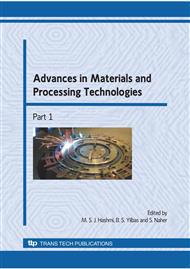p.850
p.858
p.866
p.874
p.881
p.889
p.896
p.904
p.914
Joining of Polycarbonate Ring/Disk to Metal Sheet/Shaft and its Easy Disassembly
Abstract:
For the possibility of easy disassembly of a joint assisted by strain recovery, the joint is fabricated with a cold rolled circular polycarbonate (PC) disk embedded in the center of an aluminium or a PC disk. Also, a shaft and a hollow circular disk are assembled by compressing or press fitting a cold rolled PC ring into the gap between them. First, the cold rolled polycarbonate disk is heat treated and the change in geometry is examined. Secondly, in order to evaluate joint strength, shear force and torque of the assembled joints are discussed with regard to reduction in thickness, tool clearance and interference. Lastly, joints are heat treated and the disassembly is checked. The cold rolled disk is recovered with the temperature 190°C for 20min. In embedding, disk compression in addition to rolling reduction is effective in increasing joint strength. In fabricating the shaft/disk joint, deformation of polycarbonate was not effective due to the recovery in room temperature after joining, while press fitting of the polycarbonate ring could fabricate the assembly. Heat treatment helped the joint to be automatically disassembled. The directly joined parts became completely apart, but the shaft/disk joint was disassembled only between the ring and the disk.
Info:
Periodical:
Pages:
881-888
Citation:
Online since:
December 2009
Authors:
Keywords:
Price:
Сopyright:
© 2010 Trans Tech Publications Ltd. All Rights Reserved
Share:
Citation:


